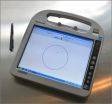The study, funded by the National Institute of Neurological Disorders and Stroke (NINDS), part of the National Institutes of Health, compared the intra-arterial device-based approach plus the current standard of intravenous (IV) tissue plasminogen activator (t-PA), a clot-busting drug with IV t-PA therapy alone. The research will be presented at the International Stroke Conference 2013 in Honolulu, Hawaii and simultaneously published online Feb. 7 in the New England Journal of Medicine.
"This is the largest trial of an intra-arterial intervention for acute ischemic stroke, and is important because it shows that the addition of devices to treat clots within the brain artery was no more effective than treatment with IV t-PA alone," said Walter J. Koroshetz, M.D., deputy director, NINDS. "Such devices are already widely used in clinical practice based on dramatic improvements seen in individuals, but without evidence supporting their overall clinical effectiveness in a large group."
Intra-arterial treatment is known to be associated with significant risk; 16 percent of the patients in the study had complications from the minimally invasive surgical procedure. The Interventional Management of Stroke, or IMS-III, is the only trial designed to assess the overall balance between risk and benefit of intra-arterial treatment in acute stroke patients.
Eliminating a clot from within a vessel involves threading a catheter through an artery in the groin up to the site of a clot in the brain, and then administering t-PA directly on the clot, which dissolves it, or removing it via coiled wires or a stent system. Based on earlier studies, researchers anticipated that adding an intra-arterial approach to standard IV t-PA would reduce stroke-related disability by providing a means to eliminate very large clots that would otherwise persist despite IV t-PA, according to the researchers led by Joseph Broderick, M.D., of the University of Cincinnati Academic Health Center.
Participants, ages 18-82 years, were enrolled in the study starting in 2006. By April 2012, after 656 of the 900 planned participants had been treated, the study's Data and Safety Monitoring Board advised that the investigation should be stopped early because 90-day outcomes showed that the benefit was not substantially different between the groups. Patients in the IV t-PA alone group (39 percent) were just as likely as those in the combination therapy group (41 percent) to be functionally independent.
All patients in the study received IV t-PA therapy within three hours of their stroke symptoms. Within 40 minutes of that therapy, 434 patients who were randomized to the device-treatment group underwent angiography to identify arterial blockages. Those patients found to have a treatable blockage received intra-arterial therapy with one of five types of devices. The remaining 222 patients were randomized to receive IV t-PA alone.
Intra-arterial therapy was 40 percent more effective at removing clots and re-establishing blood flow but it did not improve disability due to stroke. "Our study highlights that improved reopening of arteries and delivery of blood flow to the brain is not a guarantee of improved clinical efficacy," concluded Dr. Broderick, who led the team of researchers at 58 U.S. and international clinical centers.
The time to intra-arterial treatment was 32 minutes longer in IMS III compared with the two pilot studies that preceded it. This may be an important reason for the lack of clinical benefit despite substantially better revascularization with intra-arterial therapy as compared to IV t-PA. "We probably did not open the arteries quickly enough," said Dr. Broderick.
Cutting the time to intra-arterial therapy poses significant challenges, given the logistics of assembling the treatment team and room and conducting the procedure, Dr. Broderick noted. In addition, most patients do not have immediate access to the level of care required to perform intra-arterial procedures. Instead, they are often treated with IV t-PA at a local hospital then transferred to another hospital, all of which further delays the time to treatment.
IMS III sheds light on research gaps that need to be addressed in trials to develop evidence-based recommendations on the use of intra-arterial devices, said Scott Janis, Ph.D., program director, NINDS.
"These devices still may play a critical role in improving outcomes among people with serious strokes involving clots that cannot be cleared or are cleared very slowly by standard IV t-PA" Dr. Janis said.
"Future research may show that newer generations of Food and Drug Administration-cleared devices and improved patient care may change the balance of the risk/benefit ratio of intra-arterial treatment for acute stroke. In addition, neuroimaging might be useful in selecting patients who can benefit from intra-arterial therapy," said Dr. Koroshetz.
Additional information from subset analyses of the IMS III data will be presented at the International Stroke Conference in Honolulu, February 6-8, 2013.
INFORMATION:
Funding for IMSIII was provided in part through grants from NIH/NINDS (UC U01NS052220, MUSC U01NS054630, and U01NS077304). Other support was provided by Genentech Inc., Boehringer Ingelheim, EKOS Corp., Concentric Medical, Cordis Neurovascular.
References: Broderick, JP et al. "Endovascular Therapy after Intravenous t-PA versus t-PA Alone for Stroke," New England Journal of Medicine published online February 7, 2013, DOI:10.1056/ NEJMoa1214300.
NINDS is the nation's leading funder of research on the brain and nervous system. The NINDS mission is to reduce the burden of neurological disease – a burden borne by every age group, by every segment of society, by people all over the world.
About the National Institutes of Health (NIH): NIH, the nation's medical research agency, includes 27 Institutes and Centers and is a component of the U.S. Department of Health and Human Services. NIH is the primary federal agency conducting and supporting basic, clinical, and translational medical research, and is investigating the causes, treatments, and cures for both common and rare diseases. For more information about NIH and its programs, visit http://www.nih.gov.
IMS-III Investigators
University of Cincinnati Academic Health Center, Ohio: Joseph P. Broderick, M.D.; Judith Spilker, R.N., B.S.N.; Janice Carrozzella, R.N., B.A., R.T.; Pooja Khatri, M.D., M.Sc.; Thomas A. Tomsick, M.D. Medical University of South Carolina, Charleston: Yuko Y. Palesch, Ph.D.; Sharon Yealts, Ph.D.; Edward C. Jauch, M.D.; Renee L. Martin, Ph,D.; Lydia D. Foster, M.S. University of Calgary, Alberta, Canada: Andrew M. Demchuk, M.D.; Michael D. Hill, M.D.; Mayank Goyal, M.D.; Karla J. Ryckborst, R.N., B.N. University of Pittsburgh Medical Center, Stroke Institute, Pittsburgh, Pennsylvania: Tudor G. Jovin, M.D. Melbourne Brain Centre, The Royal Melbourne Hospital, University of Melbourne, Australia: Bernard Yan, M.D. University of Toronto, Ontario, Canada: Frank L. Silver, M.D. University Hospital, Dresden, Germany: Rüdiger von Kummer, M.D. Hospital Universitari Vall d'Hebron, Barcelona, Spain: Carlos A. Molina, M.D. Mayo Clinic, Phoenix, Arizona: Bart M. Demaerschalk, M.D. Riverside Methodist Hospital, Columbus, Ohio: Ronald Budzik, M.D. Oregon Health and Science University, Portland, Oregon: Wayne M. Clark, M.D. Medical College of Wisconsin, Milwaukee, Wisconsin: Osama O. Zaidat, M.D. Alexian Brothers Medical Center, Elk Grove Village, Illinois: Tim W. Malisch, M.D.; University Medical Centre Utrecht and the Rudolph Magnus Institute of Neurosciences, and the St. Antonius Hospital, Nieuwegein, The Netherlands: Wouter J. Schonewille, M.D. Bichat University Hospital, Paris, France: Mikael Mazighi, M.D., Ph.D. Basel University Hospital, Basel, Switzerland: Stefan T. Engelter, M.D. University of Sydney, Australia: Craig Anderson, M.D. National Institute of Neurological Disorders and Stroke, Bethesda, Maryland: Scott Janis, Ph.D.
END


